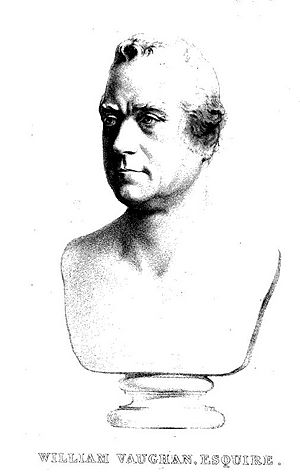William Vaughan (merchant) facts for kids
William Vaughan (born 1752 – died 1850) was an English businessman and writer. He was known as a merchant who traded with the West Indies (Caribbean islands).

Contents
William Vaughan's Early Life
William Vaughan was born on September 22, 1752. He was the second son of Samuel Vaughan, a merchant who worked in London and Jamaica. His mother was Sarah, whose father was Benjamin Hallowell from Boston, Massachusetts. William's older brother was named Benjamin Vaughan. William went to school at Newcome's School in Hackney and later at Warrington Academy.
After finishing school, William Vaughan joined his father's business. He quickly became a very important person in the world of trade and commerce.
How William Vaughan Helped His Country
In April 1782, William Vaughan traveled to Amsterdam. He met with John Adams, who later became the second President of the United States. This meeting was part of important talks to end the American War of Independence.
In 1783, William was chosen to be a director of the Royal Exchange Assurance Corporation. This was a big insurance company. He stayed involved with them until 1829, serving as a director, sub-governor, and even governor.
During the Nore mutiny in 1797, sailors in the British navy protested. William Vaughan was part of a group of London merchants who met to help solve the problem. He even wrote a short message to the sailors himself. The navy then shared his message with the sailors.
William Vaughan and the London Docks
From 1793 to 1797, William Vaughan wrote many short books and papers. In these writings, he strongly suggested building special docks for the Port of London. Docks are places where ships can load and unload goods safely.
On April 22, 1796, he spoke to a group in Parliament. He supported a new law to build these "wet docks." Later that year, he joined a committee to plan the docks. Other important merchants like Robert Milligan, George Hibbert, and Beeston Long were also on this committee.
They planned to build docks in an area called Wapping. However, the next year, Milligan and Hibbert decided to make their own docks at the Isle of Dogs. These docks were more exclusive. William Vaughan became a director of the London Dock Company in 1805.
William Vaughan's Other Interests
William Vaughan was a member of several important groups that studied science and other topics. He was a Fellow of the Royal Society, which promotes scientific knowledge. He was also a Fellow of the Linnean Society, which focuses on nature, and the Royal Astronomical Society, which studies space.
He was a member of the New England Corporation and was its governor until 1829. This group helped people in New England. He was also part of the Society for Bettering the Condition of the Poor. This group helped set up London's first savings bank in 1815. It was located at Leicester Place in Westminster.
William Vaughan was also a governor of Christ's Hospital, a famous school. He was an honorary member of the Society of Civil Engineers. In 1830, he became a member of the American Philosophical Society. Later, in 1840, he was made an honorary member of the American Academy of Arts and Sciences.
William Vaughan passed away in London on May 5, 1850. He was 97 years old.
William Vaughan's Writings
William Vaughan wrote several books and papers, mostly about docks and trade. Here are some of his works:
- On Wet Docks, Quays, and Warehouses for the Port of London, published in London, 1793.
- Plan of the London Dock, with some Observations respecting the River, published in London, 1794.
- Answers to Objections against the London Docks, published in London, 1796.
- A Letter to a Friend on Commerce and Free Ports and London Docks, published in London, 1796.
- Examination of William Vaughan in Committee of the House of Commons, published in London, 1796.
- Reasons in favour of London Docks, published in London, 1797.
- A Comparative Statement of the Advantages and Disadvantages of the Docks in Wapping and the Isle of Dogs, 2nd edition, published in London, 1799.
The first six of these writings were put together in 1797. The collection was called A Collection of Tracts on Wet Docks for the Port of London, with Hints on Trade and Commerce and on Free Ports. They were printed again in 1839, along with the Comparative Statement and other pieces. This new collection was called Tracts on Docks and Commerce, printed between 1793 and 1800.
In 1791, William Vaughan tried to create a group to help build more canals in England. Canals are man-made waterways. He collected many plans and descriptions about canals in three large books. He also helped publish a true story called The Narrative of Captain David Woodard and Four Seamen in 1804. This book was about sailors who were captured by Malays.


